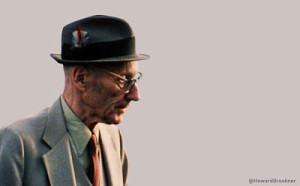STUDIO: Criterion | DIRECTOR: Howard Brookner | FEATURING: William S. Burroughs, Allen Ginsberg, Terry Southern, John Giorno, Patti Smith
RELEASE DATE: 12/15/15 | PRICE: DVD $29.95, Blu-ray $39.95
BONUSES: Jim Jarmusch audio commentary, audio interview with Howard Brookner, interview with Brookner’s nephew, footage from the 2014 NY Film Festival, over an hour of outtakes, experimental edit of the film
SPECS: NR | 90 min. | Documentary | 1.33:1 widescreen | mono
Offering an excellent “101” for those unfamiliar with the groundbreaking and influential novelist William S. Burroughs (Naked Lunch), the 1983 documentary Burroughs: The Movie touches on all the issues that were central to his work and life. The film has been out of distribution for a while (its last incarnation was as a VHS release), and this Criterion package supplements the feature with an array of audio and video interviews, as well as over an hour of eye-opening outtakes.
Filmmaker Howard Brookner followed Burroughs for five years (1978-82) and thus got glimpses of the many aspects of his subdued but acidic personality. Burroughs basically narrates his life story for Brookner’s camera, with various pieces of missing info spelled out by a small but select group of talking heads, all close friends of the author.
It is mentioned frequently in the bonus materials that Burroughs felt very comfortable with Brookner, to the extent that he was fine with discussing several deeply personal topics with him on-camera. So we move from Burroughs’ childhood experiences (as the introverted scion of a wealthy St. Louis family) to the infamous “William Tell” incident (in which he accidentally murdered his wife) and his political and social beliefs.
He doesn’t speak at any length about his homosexuality or drug use — Brooker instead uses the talking heads to address these matters, both of which were important parts of Burroughs’ life and an integral part of his writings.
Burroughs’ timeless, innovative writings are showcased in the segments where he’s shown reading to enthusiastic audiences. Brookner also offers a multifaceted portrait of his subject, taking care not to whitewash Burroughs’ emotional detachment from those around him.
The emotional center of the film is a segment about Burroughs son, William Jr. who, like his father, became both a writer and a drug addict (he died at the age of 33). A segment in which Burroughs’ young secretary and lover (now the executor of his estate) James Grauerholz rather coldly states that William Sr. is closer to him than he is to William Jr. easily makes Grauerholz the “villain” of the piece.
 An interview with Brookner conducted by a Burroughs biographer finds the filmmaker praising Grauerholz for his honesty, but one can’t help but feel that the well-groomed Grauerholz (who describes himself on-camera as “an extraordinarily competent, accomplishing person”) is somehow glorying in the fact that he was more important to William Sr. than his own son (who seems like a troubled, tragic figure in his appearances here).
An interview with Brookner conducted by a Burroughs biographer finds the filmmaker praising Grauerholz for his honesty, but one can’t help but feel that the well-groomed Grauerholz (who describes himself on-camera as “an extraordinarily competent, accomplishing person”) is somehow glorying in the fact that he was more important to William Sr. than his own son (who seems like a troubled, tragic figure in his appearances here).
Burroughs: the Movie is thus a complex look at a complex (and seemingly quite distant) artist. The supplements included here offer an even deeper look at Burroughs and the film’s lengthy period of gestation (which can be traced most easily in the number of different comb-overs and haircuts that Burroughs is seen sporting).
Jim Jarmusch, who served as a sound recordist on the film, supplies a feature-length audio commentary here, which is interesting given the fact that he’s done much less for his own works (where a Q&A with questions supplied by fans sometimes suffices). Jarmusch eloquently discusses the Grauerholz/William Jr. dilemma, but also declares his deep admiration for Burroughs and his amazement that the author carried several weapons on his person (hidden in his elegant suit jackets and pants) while he walked down the streets of NYC.
The issue of Burroughs’ fetishization of weapons comes up most prominently in the excellent collection of outtakes that are included here. Brookner is seen expressing concern to poet John Giorno about Burroughs’ love of guns and other weapons (machetes, batons, even a blow gun). Giorno responds with mild statements about Burroughs’ need for “protection.”
Brookner rightly brings up the fact that Burroughs had already fatally shot one person (his wife), and he had been pointing loaded guns at Brookner. Giorno notes that William will have to “deal with that karma himself,” but the unspoken element in that conversation is the fact that Burroughs was drinking to excess at that point and was handling weapons while he was thoroughly drunk.
The best outtakes concern Burroughs and his circle of talented friends and admirers. There is more footage of Allen Ginsberg and him talking about the old days, and a good deal more of the late, great Terry Southern and him talking about Burroughs’ weapons and his orgone box.
We also see snippets of performances from the “Nova Convention,” where a stellar group of artists paid tribute to Burroughs. The roster includes Patti Smith, Frank Zappa, Laurie Anderson, John Cage, Merce Cunningham, and Ginsberg and Burroughs. It is noted in one of the supplements that Brookner shot many hours of footage for the documentary, all of which he left with Burroughs. It isn’t revealed whether he shot the full Nova Convention performances or just the snippets that we are treated to. If the whole event exists on film, it would make for a terrific DVD package of its own.
|
Buy or Rent Burroughs: The Movie
|
|||
|---|---|---|---|
 |
|||
Leave a Reply